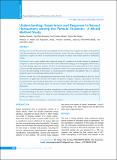Please use this identifier to cite or link to this item:
https://hdl.handle.net/20.500.14356/1341| Title: | Understanding, Experience and Response to Sexual Harassment among the Female Students: A Mixed Method Study |
| Authors: | Thapalia, Radhika Dhungana, Raja Ram Adhikari, Samir Kumar Pandey, Achyut Raj |
| Citation: | ThapaliaR., DhunganaR. R., AdhikariS. K., & PandeyA. R. (2020). Understanding, Experience and Response to Sexual Harassment among the Female Students: A Mixed Method Study. Journal of Nepal Health Research Council, 17(4), 424-430. https://doi.org/10.33314/jnhrc.v17i4.2313 |
| Issue Date: | 2019 |
| Publisher: | Nepal Health Research Council |
| Article Type: | Original Article |
| Keywords: | Abuse Sexual harassment Victimization Violence |
| Series/Report no.: | Oct-Dec, 2019;2313 |
| Abstract: | Abstract Background: Sexual harassment has received global attention and has been recognized as a public health problem with increased physical and mental health risks among the victims. This study attempted to assess understanding, experience, response and effect of sexual harassment among the secondary school female students in Kathmandu, Nepal. Methods: It was a mixed method study conducted among 441 secondary level female students. In quantitative component, a structured questionnaire was used to collect information relating to socio-demographic characteristics, and understanding, experience, response and effect of sexual harassment from 441 participants from three clusters (schools) of Tokha Municipality, Kathmandu. For qualitative method, two focused group discussions were conducted to assess the understanding of and response to sexual harassment. Quantitative and qualitative data were analyzed using Chi square test and thematic analysis method respectively. Results: Around 76% of the participants had experienced some forms of sexual harassment in their life. Sexual harassment was significantly associated with religion and parental occupation. Majority of participants who faced sexual harassment reported that the perpetrators were strangers and they either ignored it or did nothing at the time of events. School, roads and public places were the most common settings where participants encountered sexual harassment. Conclusions: Sexual harassment is prevalent among female secondary students in Kathmandu. However, they lacked a clear understating of and ways to respond to sexual harassment. Raising awareness to recognize and respond to different forms of harassment and to change the victim-blaming attitudes can be a potential strategy for tackling the problem in Nepalese society. Keywords: Abuse; sexual harassment; victimization; violence. |
| Description: | Original Article |
| URI: | http://103.69.126.140:8080/handle/20.500.14356/1341 |
| ISSN: | Print ISSN: 1727-5482; Online ISSN: 1999-6217 |
| Appears in Collections: | Vol. 17 No. 4 Issue 45 Oct-Dec 2019 |
Files in This Item:
| File | Description | Size | Format | |
|---|---|---|---|---|
| 2313-Manuscript-13223-1-10-20200121.pdf | Fulltext Download | 565.75 kB | Adobe PDF |  View/Open |
Items in DSpace are protected by copyright, with all rights reserved, unless otherwise indicated.
